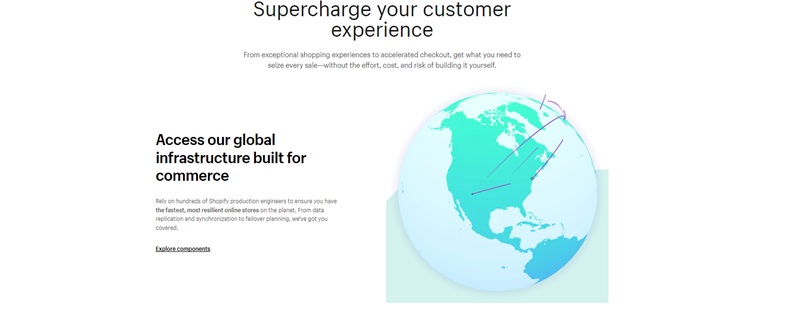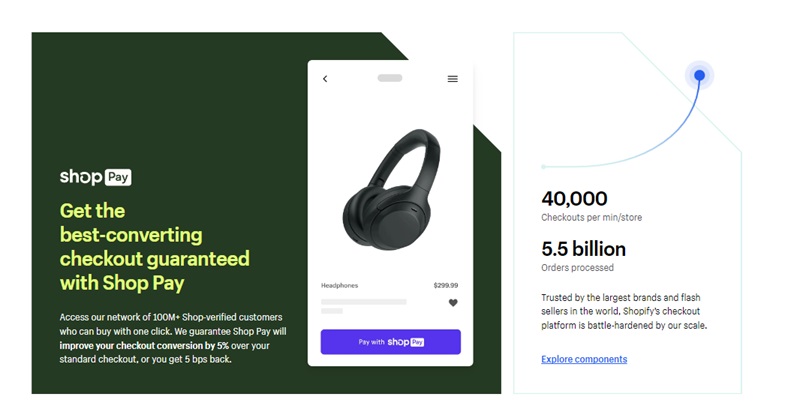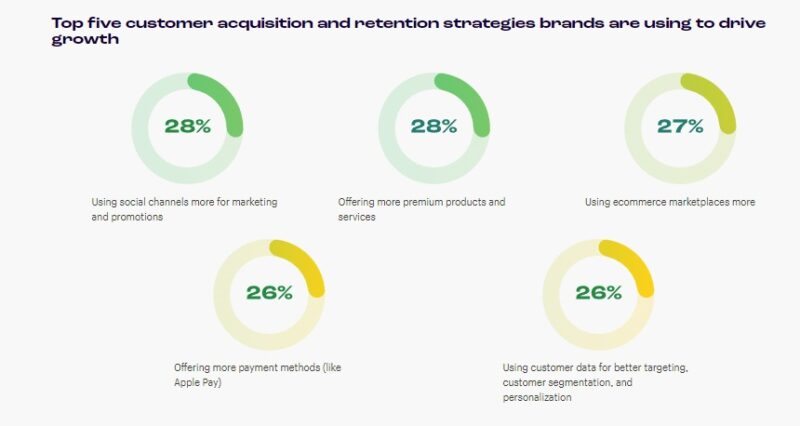My content is reader-supported by awesome people like you. Which means I could earn a commission. Learn more here!
Shopify is a popular eCommerce platform that powers over 1 million online stores.
In 2021, Shopify introduced Commerce Components, a major upgrade to how merchants can build online stores on their platform.
Commerce Components provide new modular blocks that merchants can use to quickly create custom storefronts.
Instead of building an entire online store from scratch, merchants can now use pre-built components for things like product listings, carts, and checkout.
The goal is to simplify and accelerate store development for Shopify merchants.
With Commerce Components, even merchants without advanced coding skills can create unique and powerful eCommerce experiences.
The reusable components abstract away much of the complexity of building an online store.
Now merchants can focus more on design, branding, and customization.
Shopify designed Commerce Components based on extensive research into merchant needs and pain points.
They identified common store features that most merchants require and packaged them into flexible building blocks.
By providing these ready-made components that handle the necessary logic out of the box, Shopify aims to make powerful store experiences accessible to all merchants.
The release of Commerce Components represents a major step forward for Shopify as a platform.
Let’s explore what Commerce Components are, their key benefits, and how they work.
Check Out Shopify Commerce Components
What are Commerce Components?
Commerce Components are modular, pre-built blocks of code that allow merchants to quickly build and customize online stores on Shopify.
Rather than starting from scratch, merchants can use Commerce Components like building blocks to add features and design elements through a graphical interface. The components connect to the Shopify platform so merchants can drag, drop, and edit them without needing to write any code.
Some examples of Commerce Components include:
- Product galleries
- Navigation bars
- “Add to cart” buttons
- Related products
- Testimonials
- Banners
- Footers
The key characteristics of Commerce Components are:
-
Modular – Each component handles a specific function that can be mixed and matched.
-
Customizable – Components can be visually edited and restyled without coding.
-
Connected – Components integrate with Shopify data and services out of the box.
-
Extensible – Developers can build custom components to meet specific needs.
In summary, Commerce Components provides modular building blocks to help merchants quickly create customizable online stores through a visual interface on Shopify.
Rather than starting from scratch, components allow rapid development by assembling pre-built features.
Check Out Shopify Commerce Components
Benefits of Commerce Components

Commerce components provide a number of benefits for developers building eCommerce experiences on Shopify.
Two of the main benefits are increased speed and flexibility through composability.
Speed
By breaking page functionality into reusable components, developers can build new experiences faster.
Rather than having to build every new page and template from scratch, they can pull in and combine existing components to quickly assemble the desired functionality and UI.
This component-driven approach simplifies development and accelerates the build process.
Flexibility through Composability
Components are designed to work together through clearly defined interfaces.
This makes them composable – they can be combined in different ways to achieve different results.
Developers have the flexibility to mix and match components to create unique layouts and shopping experiences.
Rather than being limited to monolithic, one-size-fits-all templates, they can build sophisticated, custom eCommerce sites by layering components.
The composable nature of commerce components allows brands to easily test variations of page designs and interactions to see what resonates with their customers.
Components can be reused across different templates and themes, which further increases developer productivity and organizational agility when iterating on UI/UX.
Overall, commerce components make it faster and easier to create flexible, high-quality eCommerce experiences that meet the needs of diverse brands and shopping journeys.
How Commerce Components Work
Shopify Commerce Components utilize a headless architecture that separates the front-end presentation layer from the back-end eCommerce functionality.
This allows the front-end website or mobile app to connect to reusable commerce components through APIs and SDKs.
The key components of this architecture include:
-
Hydrogen – A React framework optimized for eCommerce that serves as the front-end layer. It provides UI components for accessing Shopify features.
-
Oxygen – The backend serverless functions that handle functionality like cart and checkout. Oxygen exposes APIs for Hydrogen to connect to.
-
Shopify Admin – The dashboard where merchants manage their store, products, orders and more.
-
Shopify APIs – APIs provide the interface for Hydrogen to retrieve data from Oxygen and the Shopify Admin. This includes customer authentication, products catalog, cart and checkout.
The main advantage of this decoupled architecture is that developers can build customized front-end experiences using any framework like React, Vue, Angular etc. The Shopify APIs and Oxygen functions provide reusable commerce cart and checkout features that sync with the merchant’s Shopify store.
So in summary, the front-end communicates with Oxygen and Shopify Admin via APIs and SDKs. Oxygen handles the backend eCommerce functions and data.
This modular approach allows extensive front-end customization while leveraging Shopify for the backend.
Check Out Shopify Commerce Components
Key Components

Shopify’s commerce components consist of several key building blocks that work together to enable next-generation commerce experiences. These include:
Storefront API
The Storefront API is the headless commerce API that provides access to shop data. It allows developers to build custom storefronts and platforms using any frontend stack. The Storefront API delivers a standardized schema, commerce logic, and dynamic data from Shopify.
Hydrogen
Hydrogen is Shopify’s React framework for building custom storefronts. It connects natively with the Storefront API to fetch data and enables developers to build progressive web apps, static sites, and more. Hydrogen provides UI components, hooks, and helpers to accelerate storefront development.
Oxygen
Oxygen is Shopify’s Node.js framework for building headless storefronts. It is designed to help developers quickly build a production-ready storefront by providing structure, services, and deploy tooling out of the box. Oxygen streamlines access to the Storefront API.
Nitro
Nitro allows developers to build server-side rendered storefronts with React and TypeScript. It includes capabilities for SSG, ISR, static exporting, and more. Nitro optimizes performance by handling server-side rendering and hydration.
Dawn
Dawn is an upcoming Rust-based web framework for building ultra-fast commerce storefronts. It aims to provide an optimal balance of developer experience and runtime performance. Dawn will integrate natively with Shopify’s commerce capabilities.
Example Implementations
Some major brands and retailers have already implemented Shopify’s Commerce Components and are seeing fantastic results. Here are a few examples:
-
Allbirds, the sustainable footwear brand, used Commerce Components to quickly launch a localized storefront in China in just 3 months. They were able to tap into the highly customizable nature of Components to tailor the site specifically for the Chinese market.
-
Apartment Therapy, the popular home and living brand, redesigned its site with Commerce Components which resulted in a 2X increase in conversion rates. The flexible blocks allowed them to optimize and A/B test different layouts and flows with ease.
-
Ivanhoe, a boutique fitness brand, saw mobile conversion rates increase by 50% after redesigning their online store using Components. The headless architecture and composable storefront enabled them to optimize for mobile without limitations.
-
HELO, a DTC sustainable lifestyle brand, achieved a 67% increase in conversions using Commerce Components flexible blocks to create custom landing pages. Each block can be configured and tagged individually for easy page building.
-
Clearly, an optical e-commerce company, leveraged Components to quickly expand to 5 new localized storefronts across Europe. The API-driven nature of Components allowed them to easily integrate translations and payment providers.
These examples showcase the performance, customization, and speed benefits retailers large and small can achieve using Commerce Components to future-proof their eCommerce experience.
The composable storefront enables brands to optimize and innovate faster than ever before.
Check Out Shopify Commerce Components
The Future of Commerce

Commerce components represent an innovative new direction for eCommerce that will shape the future of online retail.
By breaking down monolithic platforms into modular blocks that can be mixed and matched, components enable unprecedented flexibility and customization.
For merchants, components allow stores to be designed around specific business needs rather than being constrained by off-the-shelf solutions.
Developers can build custom experiences optimized for each brand’s unique requirements.
The composable architecture also makes it easy to swap out elements or add new capabilities as business needs evolve.
On the consumer side, components will allow for more personalized and immersive shopping experiences tailored to individual preferences.
With components, merchants can deliver targeted recommendations, customize interfaces, and develop interactive or even gamified elements to make shopping more engaging.
As component-based architectures expand, expect to see radical new storefront concepts that blend social, entertainment, education, and more into the shopping experience.
The composable model will foster innovation by putting powerful building blocks into developers’ hands.
Overall, components represent a seismic shift in Ccommerce.
By breaking monolithic platforms into flexible building blocks, and components will enable a new generation of customized, innovative online stores.
The result will be better experiences for merchants and consumers alike.
Limitations
Commerce Components come with some potential drawbacks and limitations to be aware of:
-
Dependent on Shopify – Since Commerce Components are proprietary to Shopify, you become dependent on Shopify as your eCommerce platform. If you ever wanted to switch platforms, you’d have to rebuild your store from scratch.
-
Less control – With a traditional headless setup, developers have full control over the front end. Commerce Components abstract some of that control away. While it makes development faster, you lose some flexibility.
-
Can’t customize React – Commerce Components are built on React, but you don’t have direct access to React features and config. Things like React router and Redux are managed internally.
-
Limited selection – While Shopify plans to expand components, the current selection is limited compared to building a custom store. You can only use what’s available.
-
Constrained styles – The styling options for Commerce Components are more constrained versus building your own CSS. You have to work within the parameters of the components.
-
Scaling limitations – Commerce Components may not be ideal for enterprise-level stores anticipating huge scale and traffic volumes. Traditional headless setups give you more optimization control.
-
Can’t reuse chunks – Since everything is handled by Shopify, you can’t break up your UI into reusable chunks of code like you can in traditional React apps.
-
No offline mode – There is no offline mode for Commerce Components currently. Your store won’t function without an internet connection.
In summary, Commerce Components trade some flexibility and control for faster development speed.
They are ideal for small to medium stores that don’t require heavy customization. However, they may not be the best fit for larger enterprise use cases.
Conclusion
In summary, Shopify’s commerce components provide merchants with a powerful new way to build modular, customizable online stores.
By breaking down eCommerce functionality into reusable components, Shopify enables developers to mix and match elements to create unique shopping experiences.
Key benefits of using commerce components include increased speed and flexibility in designing online stores, easier maintenance and updates, and the ability to share and reuse code between projects.
While commerce components are still relatively new, they have the potential to significantly change how eCommerce sites are built going forward.
Some limitations exist, like the need to learn a new development paradigm and restrictions around customizing the pre-built components.
However, Shopify is actively developing more robust documentation, tools, and support to improve developers’ ability to work with components.
Overall, commerce components represent an exciting evolution in how modular, scalable, and high-performing online stores can be constructed.
As the platform matures, we will likely see components become the standard way new Shopify themes and apps are developed.
For Shopify merchants and developers on the cutting edge, investing time to understand and utilize components now can provide a real competitive advantage.





Leave a Reply